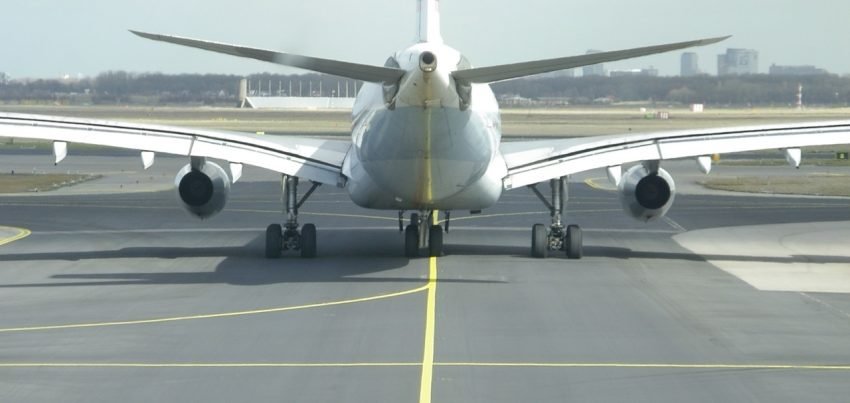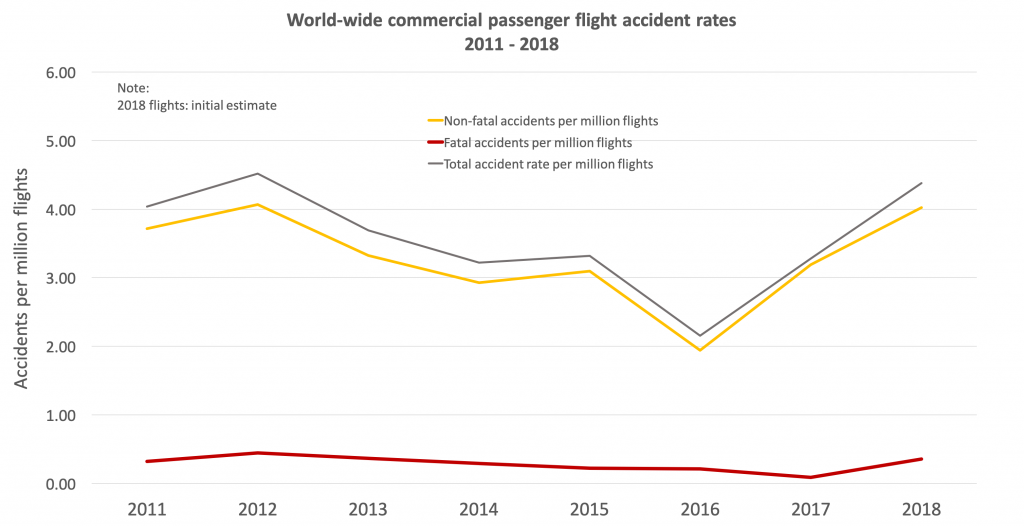Sadly, the historical lack of fatal civil aviation accidents involving large turbojet-powered passenger aircraft in 2017 was not to be continued in 2018. In fact, the number rose to slightly above the most recent five-year average. Whilst aviation is still one of the safest modes of transport, the lack of fatal accidents in 2017 was apparently the anomaly we were afraid it would be.
[blockquote text=”Whilst accidents in commercial air transport remain rare, the industry must remain alert” text_color=”#004361″ show_quote_icon=”yes”][vc_separator type=’transparent’ position=’center’ color=” thickness=’5′ up=” down=”]
Our statistics: 2018 in review
Our To70 Civil Aviation Safety Review examines accidents only to larger passenger aircraft commonly used by most travellers. (See our criteria in the Note below.) We include all causes, whether technical failure, human error or unlawful interference.
In 2018, there were 160 accidents, 13 of which were fatal and resulted in 534 fatalities. These numbers include one accident due to unlawful interference.
Fatal accidents to large passenger aircraft remain rare events. An estimated 7% growth in air traffic for 2018 over 2017 puts the rate of fatal accidents for large aeroplanes in commercial air transport at 0.36 fatal accidents per million flights. That is a rate of one fatal accident every 3 million flights. This years’ fatal accident rate is higher than the most recent 5-year averages (2012-2016: 0.31 and 2013-2017: 0.24).
By way of comparison, in 2016, there were 71 civil aviation accidents of which 6 resulted in fatalities. In 2017, the number was historically low: 48 accidents including two fatal accidents resulting in the loss of 13 lives. Both of those fatal accidents were to regional turboprops; the number of fatal accidents involving large turbojet-powered passenger aircraft in commercial operation was zero in 2017.
A diversity of causes
The first accident in 2018 involving a large passenger aircraft was on 5 January: a ground collision between two Boeing 737 aeroplanes at Toronto’s Pearson Airport. The first accident of the year to be widely reported was a Boeing 737 operated by Pegasus Airlines that slid off the runway at Trabzon Airport in Turkey on 13 January. Fortunately, no one was seriously injured in either accident.
The prediction in our 2017 Safety Review that the low accident rate was a question of simple luck was proved on 11 February in Russia. On that day, the first fatal accident of 2018 occurred when an Antonov An-148 operated by Saratov Airlines crashed after taking off from Stepanovskoye and 71 people were killed. As we noted in January of last year, the incredibly safe year for commercial aviation that was 2017 was very unlikely to be repeated.
There were two rather unusual accidents in 2018 that would not normally be included in our results. The first was a notable accident in Europe involving an historic piston engine aeroplane. On 4 August, a vintage Junkers Ju-52 aeroplane operated by a Swiss company crashed with the loss of all 20 persons on board. The second highly unusual instance is also the single case of unlawful interference in our database. In August, a young man stole a Dash 8 from a Seattle airport and crashed it into Puget Sound.
The widely-reported Lion Air accident in October with a brand-new Boeing 737 Max aeroplane caused the largest single loss of life in 2018: 189 people died near Tanjung Bungin, Indonesia, when the aeroplane crashed into the sea shortly after take-off.
What the accidents can tell us
As in previous years, Europe and North America remain the safest parts of the world to fly in. Accidents here are rare. The bizarre misfortune that led to the death of a single passenger in a Boeing 737-700 following an uncontained engine failure during flight is one of the rare accidents in North America.
The mention of Boeing’s 737 several times in this article should not be seen in a negative light. There are as many accidents within the Airbus 320 family as there involving 737s. However, the possibility that the Lion Air accident may have a technical cause is of serious concern, considering that the MAX is the future of the successful 737 model.
Whilst accidents in commercial air transport remain rare, the industry must remain alert to incidents and accidents from which lessons can be learned. We will be studying the causes of these accidents in 2018 as the investigations progress.
About our methodology:
To70 uses official figures reported by States to the UN’s aviation agency, ICAO, to determine the number of civil aviation flights that have taken place in any given year. The actual figures, published by the air transport organization, IATA, are used to estimate the current year’s figures. We update our database each year when the actual flight numbers data for the previous year becomes available.
Accident data is derived from publicly available databases, aviation authority websites and sources such as the ICAO’s ADREP database. Only accidents to civil-operated passenger flights on airliners are considered. Unlike statistics produced by IATA and ICAO, accidents involving unlawful interference are included in our analysis. Airliners are defined here as powered by turbo-prop or turbofan engines and having a maximum take-off mass greater than 5,700 kg. Certain relevant exceptions may be included regarding smaller turbo-prop aeroplanes just below this mass limit (e.g., the De Havilland Twin Otter). Accidents to military flights, training flights, private flights, cargo operations and helicopters are excluded. As the vast majority of commercial air transport operations take place with large aeroplanes, the effect of the excluded types on the accident rate is very small.
About To70. To70 is one of the world’s leading aviation consultancies, founded in the Netherlands with offices in Europe, Australia, Asia, and Latin America. To70 believes that society’s growing demand for transport and mobility can be met in a safe, efficient, environmentally friendly and economically viable manner. To achieve this, policy and business decisions have to be based on objective information. With our diverse team of specialists and generalists to70 provides pragmatic solutions and expert advice, based on high-quality data-driven analyses. For more information, please refer to www.to70.com.


